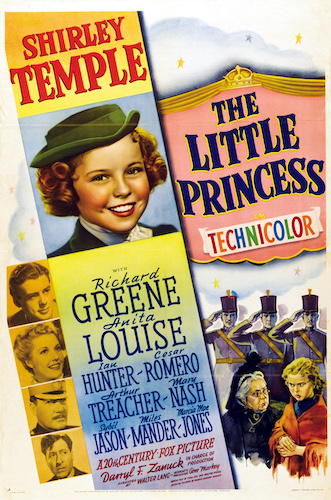National Kids Day: The Little Princess
As part of National Kids & Pets Day, we decided finding nostalgic childhood films was a bit easier than combining both themes. We are taking this opportunity to review ten films that have been deemed staples of the youths of varying generations. This article looks at The Little Princess.
There is some context as to why I went with this film. Firstly, it has been done a number of times, as the original source (A Little Princess, by Frances Hodgson Burnett, clearly captured hearts). The earliest known example is a Mary Pickford silent film. A well known version is this Walter Lang rendition (Alfonso Cuarón’s A Little Princess will definitely be looked at in the future; there were enough ‘90s childrens films competing for this group of reviews). It marked the very end of Shirley Temple’s highly successful child star run. It also was the first (and only) Technicolor film of Temple’s classic canon. Essentially, selecting a Shirley Temple film made sense. During the dawning of classic films being shown on television, one notable revitalization was the nostalgia attached to familiar faces. Shirley Temple was being shown to a new crowd, in the same way It’s a Wonderful Life was back and stronger than ever before.
This Shirley Temple film was the portal towards maturation. In 1939, a certain film called The Wizard of Oz came out and revolutionized family pictures. I don’t believe The Little Princess was an awareness of this shift, but it did mark the perfect timing in very notable ways. This departure towards adult themes was one that truly allowed Temple to showcase her range; is she a child star because of her charm, or because she truly is a star? The Little Princess is a great argument for the latter, as Temple combats many scenes as the primary voice for each moment.
Sara making a birthday wish for her father to come back home.
This serious look at a child facing adult concerns is done rather powerfully. With so many bright pastel colours to signify Sara’s worth, we start off the film bubbly and promising. Her father (played by Ian Hunter) is a captain called to fight in the Second Boer War. No matter. His daughter can stay at a boarding school, and have the nicest room there is. Things won’t be so bad, right?
Once it is announced that he has been killed in action, things take a drastic turn. Sara is immediately shunned (who’s going to pay for the expensive room and the birthday party, now?); she is cast into the attic, and forced to wear dark rags. Empathy doesn’t quite exist, here. The money comes first. It may be harsh to see a child go through this, but that’s sadly how unforgiving life can be. The Little Princess nails that collapse, in a way that seems respectful for all audiences.
Sara with her dad before he leaves for duty.
Sara doesn’t believe her father is dead, and she insists on going through every hospital or treatment centre to find her father. There are only three short musical numbers, here. This is Shirley Temple growing up. This is an abandonment of youth for something stronger; something more meaningful. This search, and the stripping of over-theatrics, is such a noteworthy turn, that it can be seen as her definitive film despite being a farewell to her classic run.
Things could be a little stronger (I will try my best not to bring up Cuaròn’s A Little Princess in comparison, of course). The biggest elephant in the room is Cesar Romero with dark skin applied, to play an Indian servant. Fortunately, this role doesn’t seem to try and be offensive (or play a culture in a stereotypical way), but this is a reminder that times were very different (and at least some greater strides have been taken). That won’t devalue the score, because this was hardly the only film to be ignorant back then (and we would be here all day discussing how many classics were considerably insensitive through a much more progressive lens).
Sara during a dream sequence, in which she is a literal princess.
What could have been fixed, mainly, is the revelation of the film’s conclusion too early. The impact of a sudden realization could have been great. Trying to work with dramatic irony (the audience knowing something a lead character does not) kind of stales the final moment. Why allow a tortured child to suffer longer than we know is necessary? Some depth towards the less favourable characters would have also sufficed, and the stiffness of character tropes back in the day is not a good enough reason (a villain should have a more understandable reason to be evil, rather than just to be evil).
Aside from that, The Little Princess is a strong film that can be a family picture if guardians are nearby to educate the young viewers with them. This is a heavier youth film that treats most of its discussions with severity, and not with sugar coating. It was as much of a transitional period for Shirley Temple, as it can be for child cinephiles; this makes a reasonable stepping stone from a more friendly film, to more mature works. It’s a reminder why Shirley Temple captured a nation in the ‘30s, and how an exit from fame doesn’t have to be loud or abrupt (but maybe classy).
Andreas Babiolakis has a Masters degree in Film and Photography Preservation and Collections management from Ryerson University, as well as a Bachelors degree in Cinema Studies from York University. His favourite times of year are the Criterion Collection flash sales and the annual Toronto International Film Festival.







